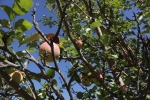This article is part of series called The Boulder Apple Tree Project: harvesting history. Read part 1 here. Read part 2 here.
If you’re interested in volunteering for the Boulder Apple Tree Project, an information session about history research will be held Saturday, February 1st. More details here.
In summer, Boulder is a secret city, a thick patch of forest nestled against the base of the mountains. Only the high-rise dorms and the lights of NCAR on the mesa serve as reminder that this deep swath of trees hides a hundred thousand people, an urban forest rather than a wild one. The forest holds records of Boulder’s history and resources for our city’s future.
The trees throughout Boulder provide a host of benefits, also called ecosystem services. These include shade, biodiversity, temperature control, and air filtering. But some cracks have formed in our canopy as the emerald ash borer, an invasive beetle, has spread through large areas of North America, putting 15% of Boulder’s urban forest at risk. Apple trees could be a perfect replacement for ash trees when the ash borer strikes.

Picture credit: Bridget Menasche
Which apple varieties should we plant – and where in the city should each one go? Boulder Apple Tree Project researchers like EBIO graduate student Deidre Jaeger hope that their work on the response of different apple cultivars to local temperature will help decide. The trees best fit to different environments could provide short-term ecosystem services like shade, and long-term ones like the ability to withstand and control urban heat radiation, the warmth absorbed by city concrete and later released into the surrounding environment.
The trees that have persisted since before the industrial revolution could point to the ecological and genetic features that make them adaptable to climate change. “We’re collecting the history of trees approaching the end of their lives; now is a great time to study them”, Jaeger explained.
Finding the heritage trees that could unlock a better urban forest needs more than biological research – that quest depends on historical detective work.
During the 2018 Apple Blitz, volunteers collected historical data to identify these ancient trees. For each sample site on private land, someone spoke to the landowners, asking them about who planted their trees and when, what they’ve used the trees for in the past, if they’ve seen wildlife using the tree, and their favorite memories of the tree. Those interviews provided raw research material for Amelia Brackett, a Ph.D. candidate in the History department studying with Dr. Thomas Andrews.
Local history can describe both people and landscape. In fact, local history depends on connecting the two, making the Apple Tree Project a “great opportunity to open up all the connections”, Brackett explained. When we talked last September, Brackett had already pored over oral history recordings, physical archives, government documents, and newspaper articles. She even studied models of county fair prize-winning apples created in the early 1900s by Miriam Palmer, a CSU professor (and a tough-as-nails female scientist).
She panned through the Apple Blitz interviews for clear stories with details like dates, apple cultivars, the names of previous property owners, and “anybody who’s a descendent of anybody”. She also looked for oral histories told by people with documents to support the details.
“Local history – at least my experience of it – is like detective work,” said Brackett. She stressed the challenge of corroborating and integrating people’s stories with the concrete historical record like government documents and newspaper articles. “My information needs to be tied together,” she said. Over the summer, she worked with Front Range Community College students to connect apple tree surveys to archival documents from Carnegie Library for Local History and the Earth Sciences and Map Library on campus.
When Brackett interviews sources, they reveal similar attention to detail. When I asked how she balances getting information and pushing too much, she said “I don’t think that’s going to be a problem; I’ve never talked to someone for a short amount of time about their apple trees.”
Brackett sees those stories as more than historical and scientific documents, but a method for public engagement. One core part of local history, and oral history specifically, is helping people feel connected while they tell their stories.
Those personal stories also contribute to a broader understanding of the landscape. Brackett explained that studying Boulder’s apple trees helps describe the ecological impact of westward expansion in the 1800s. The landscape wasn’t just changed by white people themselves: they brought apples with them, and some of those apples adapted to, and altered, their new environment. Brackett sees the Boulder Apple Tree Project as one way to show how “human actions have impacts beyond what is in control of humans.”
Combining historical and biological research will help us understand that impact. The spatial information generated by Brackett’s historical research ties directly to the ecological data collected by the Wessman and Suding labs. Historical information about the locations of homesteads, commercialized orchards, and wild trees will fill in gaps in the scientific descriptions of how apple cultivars respond to different microenvironments. One goal is to layer those types of information onto one map: zoom in on a single tree and get ecological, genetic, and historical data.
The Boulder Apple Tree Project plans to use Brackett’s research and Apple Blitz data to help preserve heritage apple cultivars in orchards, not just in historical records. Apple trees only live a hundred to two hundred years, but they can be maintained by grafting: cut a few branches from an old tree, bandage it to the base of a younger, hardy tree, and let it take on new life, carrying its genetic diversity and unique properties forward as it grows again. Farmers graft branches bearing known fruit to their trees in order to propagate the familiar apples (Granny Smith, Gala, even the disappointment that is the Red Delicious) that you find at the grocery store. Apple Tree Project researchers want to create a collection of grafted trees in order to preserve historic varieties of apples, and to prevent the disappearance of cultivars when the old trees die.
Apple Tree Project researchers have also proposed planting multiple orchards throughout Boulder to promote research, teaching, and conservation in the long term, which Jaeger described as a “common garden experiment”.
Even if those orchards bloom, the Apple Tree Project will continue to grow through citizen science. Both Jaeger and Brackett were taken with people’s attention to their apple trees. Jaeger hopes to develop a citizen science component of her phenology work. While she monitors tree cuttings in the greenhouse, some landowners might do the same with their trees, taking note of the time of budding and flowering. (Other researchers, including the Curio project organizers and Mark Hineline at Michigan State University, have encouraged homebrew phenology for conservation and studying climate change).
Ultimately, Apple Tree Project researchers hope to use human connections to the environment to learn about local history and ecology, and to make that knowledge easy to understand. As Jaeger put it, “part of citizen science is making sure that people have a way to find out what happened”, what their hard work contributed to. Citizen scientists are already contributing to Boulder’s urban forest.
By Bridget Menasche





Comments are closed.